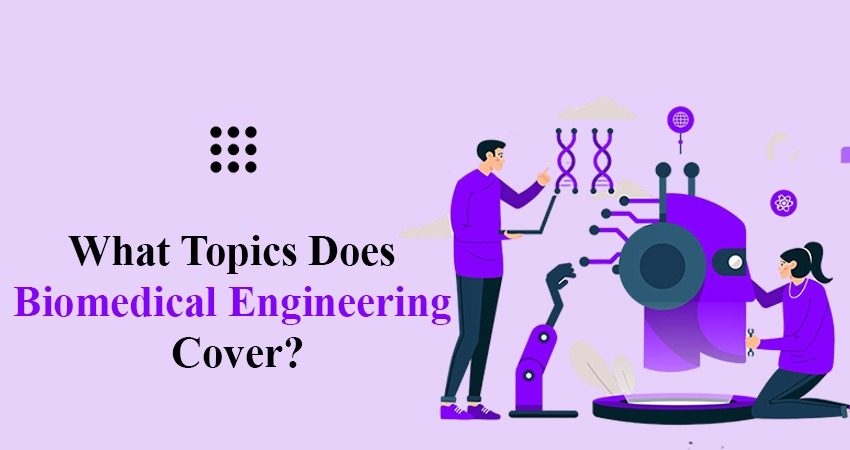What topics does biomedical engineering cover? from Engineers Heaven's Idea / Prospect

Biomedical engineering is a broad and exciting field. It combines the principles of engineering with the medical sciences to enhance healthcare. It is critically important in modern medicine, from advanced prosthetics to life-saving imaging systems.
Overview of Biomedical Engineering
If you are someone who is looking to enter the field of biomedical engineering and enjoy all facets of mechanical engineering and medicine, then Engineer's Heaven hopes to help you navigate the new and dynamic world of biomedical engineering! This blog aims at providing you with the core concepts included in this area.
Personalized medicine, genomics, and gene therapy
Medical imaging is one of the most vital aspects of biomedical engineering. Imaging techniques such as MRI, CT scans, and ultrasound assist healthcare providers in the accurate diagnosis of illnesses. It is heavily based on physics, signal processing, and artificial intelligence to generate clear medical images.
They are also biomedical engineers who help enhance imaging quality, minimize radiation hazards, and increase device efficiency. Modern medicine would face tremendous challenges regarding early disease detection without these innovations.
Prosthetics and Bionics
Thousands have revolutionized hundreds of millions of lives with prosthetic limbs and bionic implants. Scientists create prosthetic limbs that closely replicate natural movement. A few even link to the nervous system, giving users the ability to control using their thoughts.
Bionics go beyond limbs. Some of these implants serve the blind (retinal implants), and others restore hearing (cochlear implants). These technologies are being updated and secured by biomedical engineers, making them more effective and available.
Tissue Engineering and Biomaterials
The human body is complicated, and even replacing damaged tissues is a huge hurdle. This is why there are biomaterials and tissue engineering—scientists design materials happy in your body that can be used as artificial skin, bone grafts, or heart valves, for example. That would be tissue engineering. Stem cells can be used to grow human tissues in laboratories. Hopefully the next step would be growing whole organs to avoid the need for organ transplantation. The field is at the forefront of medical innovation.
Med Devices and Wearable Tech.
Biomedical engineers create medical equipment that facilitates treatment and patient monitoring. Trainable examples include pacemakers, insulin pumps, and dialysis machines. These devices treat chronic diseases and improve patient outcomes.
The field of wearables is another burgeoning one. Smartwatches and fitness trackers measure heart rate, oxygen levels, and, increasingly, early signs of disease. Engineers are trying to make these devices more accurate and reliable.
Biomechanics & Rehabilitation Engineering
Biomechanics deals with the movement and function of the body. Engineers study how things move and use this information to create solutions for people who struggle with mobility. Rehabilitation engineering develops assistive technologies, such as robotic exoskeletons and ergonomic chairs.
These advances are assisting stroke patients in recovering movement and enhancing the quality of life for people with disabilities. This field is expanding the realm of the possible by combining engineering with human biology.
Scientists are also considering methods to build synthetic organs and tissues via genetically engineered cells. The potential is immense, making this one of the brightest fields within biomedical engineering.
Artificial Intelligence & Machine Learning in Healthcare
Data science is revolutionizing healthcare. Biomedical engineers design AI-assisted diagnostic software, predictive algorithms, and robotic surgical equipment. This includes using AI to analyze complex medical data, which enhances both the decision-making process and the accuracy of the results.
They help with detecting diseases, planning treatment, discovering drugs, etc. These innovations help streamline processes in the medical field, which minimizes human errors and leads to better patient outcomes.
Biomedical Engineering: The Future Image of the Profession
The future of medicine is being shaped by biomedical engineering. We can anticipate more intelligent devices, precision treatment, and going in bioengineered organs.
We offer techniques and career advice on biomedical engineering topics at Engineer's Heaven. From innovators looking to deepen their understanding of the field to novices starting their careers, we make sure you have all the resources you need.
(Disclaimer: This statistics could be different in different part of World and Different timeline. this statistics has been generated based on data available till 2025 or relavant time span.)

The Wall